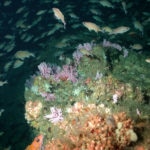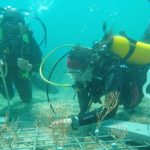A hospital for the corals of the Mediterranean
There are over 200 coral species in the Mediterranean. They are not as spectacular and have not suffered in 2016 as much as the Australia’s battered Great Coral Reef, but they are essential to nurture marine life. Some live at depths of hundreds of meters and are seriously damaged. An research team funded by the BBVA Foundation studies how to heal them.

For centuries, the fishermen of cape Creus, on the western fringes of the Iberian Peninsula, have known that the secret to the abundance of fish in the area lies at the bottom of the sea that feed them. However, only recently did they learn that these waters owe their richness, to a large extent, to the cold water corals that thrive at depths of hundreds of meters deep, providing food and shelter to fish and crustaceans.
Fishermen nets are precisely one of the most severe threats that these valuable ecosystems face, which remained unknown for science until just a few decades ago. Offshore oil platforms and global warming are the other two biggest threats to these underwater gardens, compared by many to rainforests due to the enormous biodiversity they harbor.
“Increasingly aggressive fishing has caused, and still does, severe damages to populations of species such as corals, gorgonian corals and sponges,” said A Andrea Gori, coordinator of de ShelfReCover, a project funded by BBVA Foundation that tries to help Mediterranean deep-sea corals recover.

Hydrocoral and squarespot rockfish on Cortes Bank - NOAA
“Fishermen call us when gorgonian corals get tangled in their nets and we carry them all the way to our experimental aquariums in Barcelona to heal them before restoring them back to their natural habitat,” says Gori.
This procedure is already being successfully applied with tropical corals, which live closer to the surface, but – at least as far as Gori knows – it has never been tried before with deep-sea corals.
To put the corals back at the bottom of the sea we use steel structures designed especially for this function. We place these landers at depths of over 80 meters, using underwater robots on loan from the University of Gerona, which are also used to monitor how the underwater forest grows.

ShelfReCover project researchers supervise how the underwater forest grows.
The first results of the research study have been extremely favorable. “We’ve been able to prove that, despite trauma and wounds inflicted by the nets, over 90% of the corals that we managed to transplant in 2015 were still alive one year later,” said Gori.
The next step will be to start applying the techniques developed in the Mediterranean in other seas because, unlike their tropical relatives, cold-water corals can be found virtually in all of the world’s oceanic basins.
“Last summer we stated taking part in a similar experiment in the Azores islands. We are also planning to carry out actions in the Gulf of Mexico,” said the researcher, excited about the opportunity to continue protecting one of the most threatened ecosystems in the world.